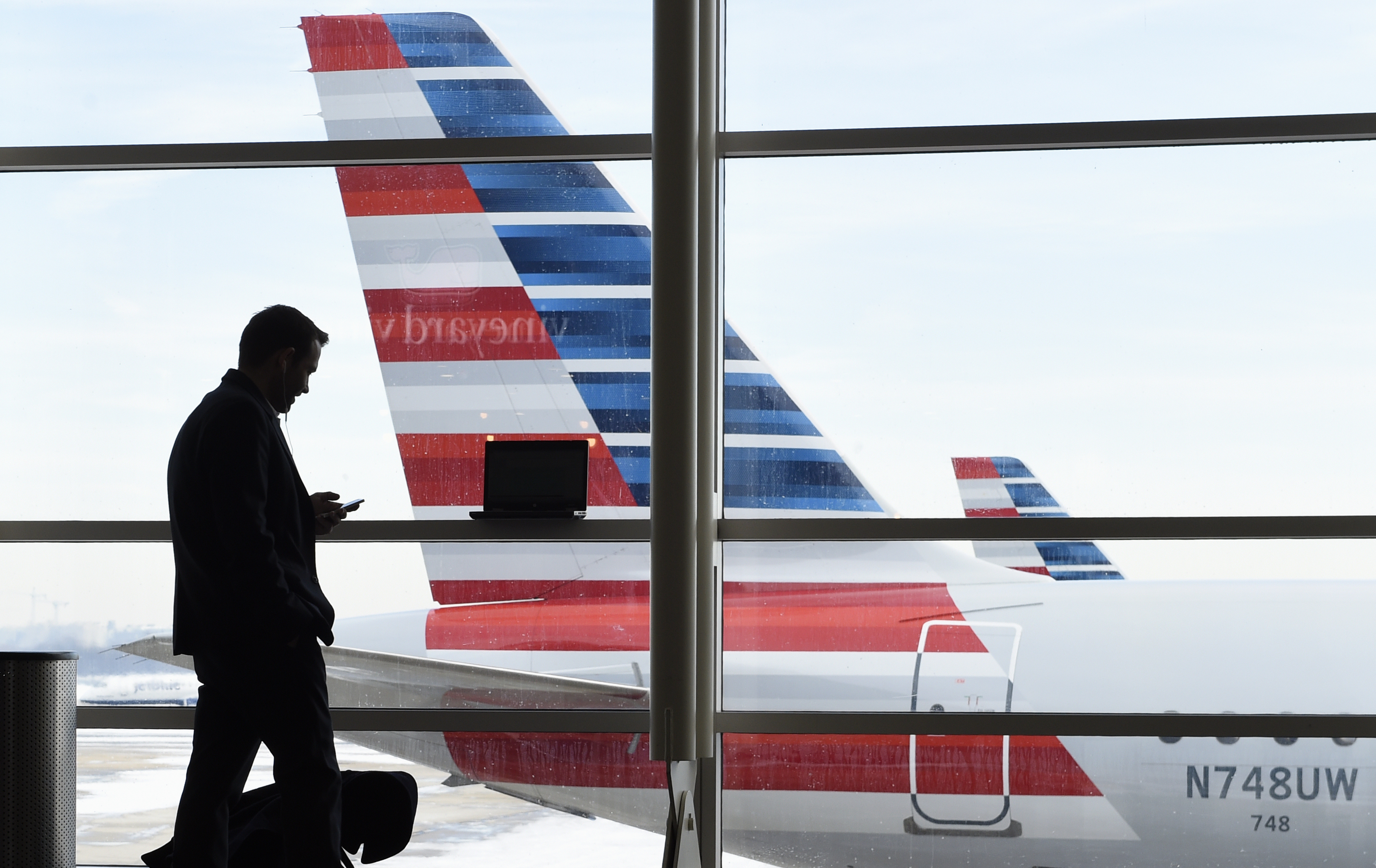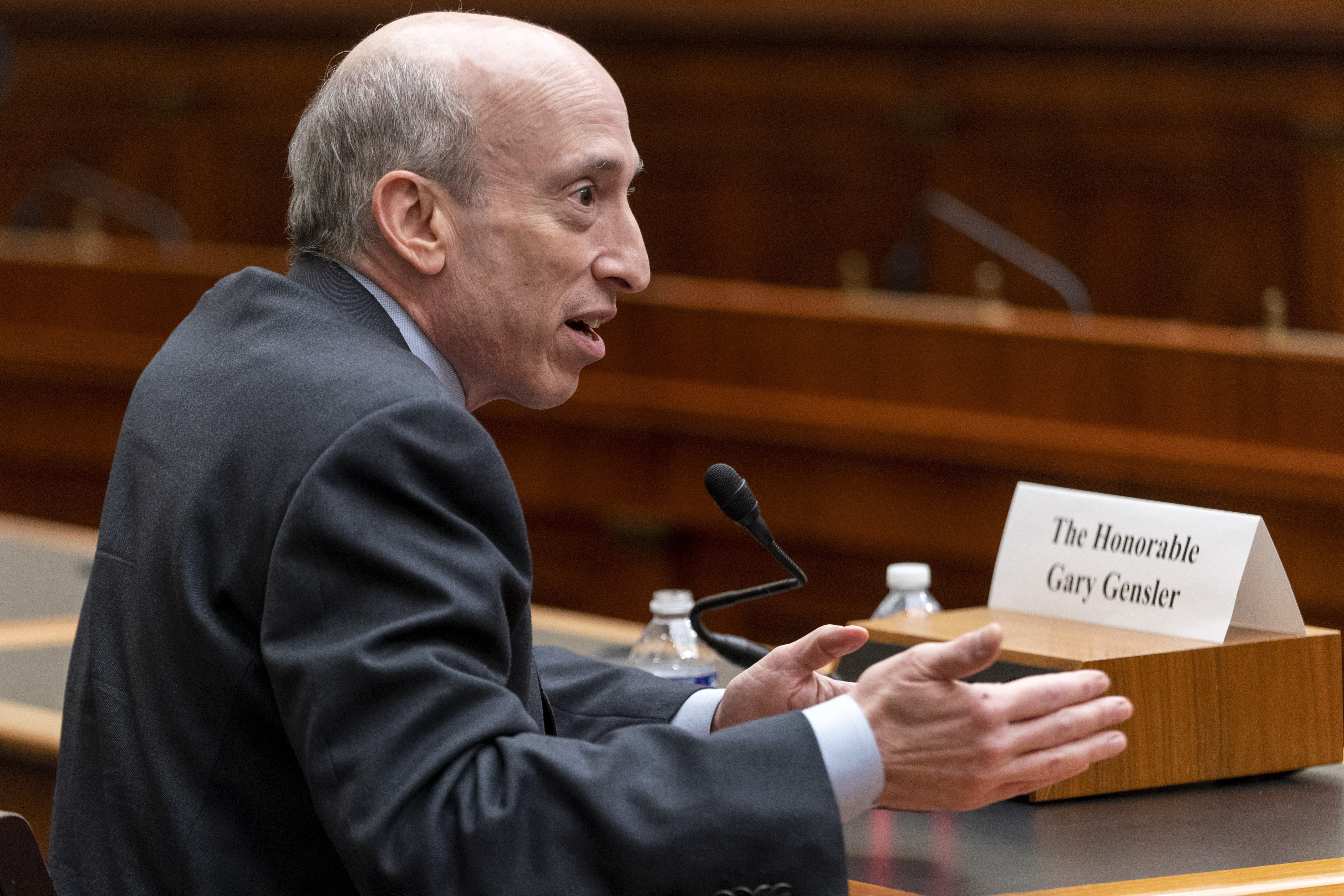RICHMOND, Va. (WAVY) — The House Appropriations Committee gave a presentation regarding changes to the Virginia Military Survivors and Dependents Education Program, or VMSDEP, on Tuesday.
The program currently assists eligible children of veterans get their education paid for. The new changes could mean more veteran’s and their families will be required to pay partially out of pocket for schooling where it would originally be covered. This is in part due an influx of students eligible for the program following changes of requirements in recent years.
This is concerning to some of the Virginia families that spoke with 10 On Your Side.
Currently, the children of veterans who are more than 90% permanently disabled, or who were killed in action or taken prisoner, can have their tuition waived for up to eight semesters at a public college or university in Virginia, regardless of tuition increases.
However, changes to the program require families of students who were not enrolled in schools by May 15 to apply for financial aid and potentially pay out of pocket before using a tuition waiver.
The presentation addressed some of the challenges and wanted to do so in conjunction with the upcoming task force meeting.
They addressed some of the challenges and talked about the history of the program. Leaders said the program has grown significantly in the past five years, growing from a $12 million a year to $65 million a year. They said there’s been a 450% jump in the past five years and estimate the program to cost $85 million in the next year if it continues as is.
“As you can see the program from 2010 to 2019 was a fairly stable program,” said Legislative Fiscal Analyst Tony Maggio. “It had some slight growth, but it was something that was manageable at the time. 2019 was the inflection point.”
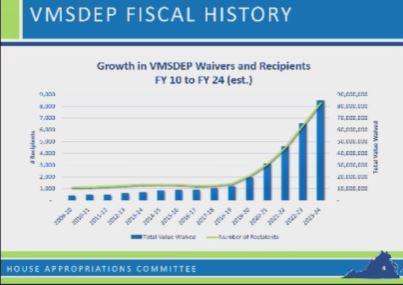
Maggio said the 2024 numbers are estimates, but the 2023 numbers are coming from actual institutions.
Timeline of changes
The program started back in 1930 for soldiers returning from WWI as an appropriations based program. Eligibility was limited from ages 16-25. The students had to be citizens of the Commonwealth at the time the parents entered the military, and eligible students were limited to those whose parents were killed, or totally and permanently disabled, due to war service.
The program had undergone changes in the late 1970s and early 1980s to expand to dependents to include those who were citizens of the Commonwealth at least 10 years prior to the application by the child. Then in 1998, legislators reduced the citizenship requirement from 10 years to five years.
There was a number of changes after 9/11, which is when the spousal clause was added in. The age limit range was also increased from 16 to 29 and as part of it, the academic progress requirement was removed.
In 2007, the program shifted from an appropriations based program to a tuition wavier, and the stipend itself was created. The stipend is a fixed amount that was created to help offset the cost of room, board and books. It remained that way until 2014.
In 2014, the Virginia citizen requirement was removed and it was changed to five years physical presence to be eligible for the program.
In 2019, the eligibility was expanded again to include all service-related injuries, rather than deaths/injuries during armed conflicts, but only for the waiver part of the program. The stipend portion of the program remained identical.
Maggio said the fiscal impact statement was key. He said when the legislation was considered in 2019, the fiscal impact statement indicated it would be about 500 applicants growth and about $5.4 million.
The impact statement also noted the anticipated impact on three Universities: George Mason, VCU and Old Dominion. It noted the impact on George Mason would be about $550,000, but he said by 2021, the fiscal year impact was $2.7 million. He adds the impact for ODU was anticipated at $900,000 and by 2021 it was $2.8 million. He said at VCU, the fiscal impact was anticipated to be $1.2 million and by 2021 it was $3.5 million.
In 2022, Maggio added the program was expanded to include stepchildren of deceased military service members — provided that the service member claimed the stepchild on their tax return or defense enrollment reporting system while serving on active duty.
Difference in stipend vs waiver recipients
Advocates for the program refute these numbers, as 10 On Your Side has previously reported.
Friends of VMSDEP co-founder Kayla Owen was also asked to be on the task force. She said there are concerns about how these numbers were calculated, and that’s why their group called for a more comprehensive study.
“The data from, if you look at DVS versus the schools versus SCHEV, you will find different numbers depending on which one of those numbers you’re actually looking at,” Owen said.
Owen said when you use this program for a semester, whether you use it for three credit hours or whether you use it for 25 credit hours, the imputed cost is the same.
“We know that many of the students who utilize this program do so part-time because they’re a working spouse or there are other components in their lives that prohibit them from using it full time,” Owen said. “They are imputing a full-time cost for student regardless of their actual student status.”
This was addressed during the presentation.
“I think there are concerns about the number of waiver recipients as being overstated and it might be just because there is a difference between the growth [of] the waiver recipients and the growth [of] the number of stipend recipients,” said Maggio.
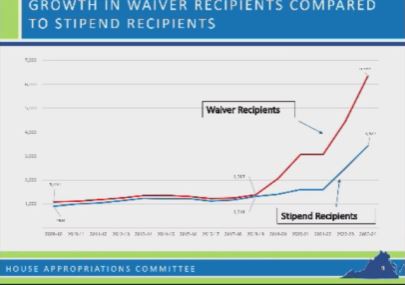
Maggio said until 2019, the two track very closely, which is when the eligibility was expanded again to include all service-related injuries, rather than deaths and injuries during armed conflicts.

The influx of students in the waivers program created an imbalance as universities absorbed their cost of tuition, Maggio said. This means that other students had to pick up the difference in the form of increased tuition.
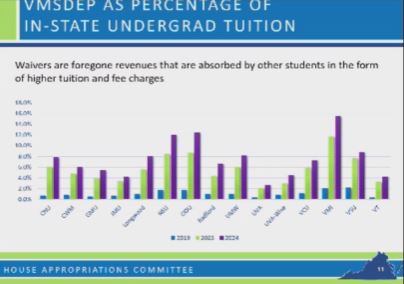
The in-state undergrad tuition increased over the years.
“Institutions that were impacted by this in some ways include CNU, Longwood, Radford, Mary Washington and VCU [in-state tuition] all went from being roughly 6% in 2023, they’re now going to be close to 9%,” said Maggio. “Norfolk State, Old Dominion and Virginia State in 2019 were roughly around 2%, they jumped to roughly around 8-9%, and now in 2024, they’re estimated to be about 13%.”
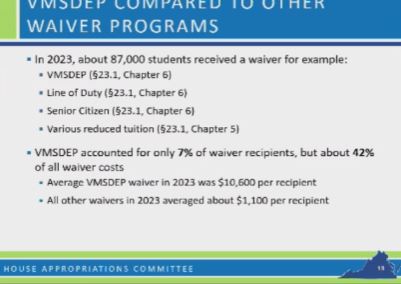
“VMSDEP only accounts for 7% of the waiver recipients but they account for up to 42% of all the waiver costs,” said Maggio. “The average VMSDEP waiver is $10,600 dollars in 2023, the average waiver for all other waivers averaged together is $1,100 per recipient so its a significant portion of the waiver programs.”
They also compared Virginia’s program to other states, like Texas, California, Kentucky and Florida. Maggio says those states have checks and balances for their programs and they based some of their reforms on other programs.
Some of their reforms include looking at limiting the award to the first undergraduate degree, requiring the completion of FAFSA, restoring the notion of satisfactory academic progress, and if the student chooses to use other benefits that are dedicated to the payment of tuition and fees they would be applied against the waiver.
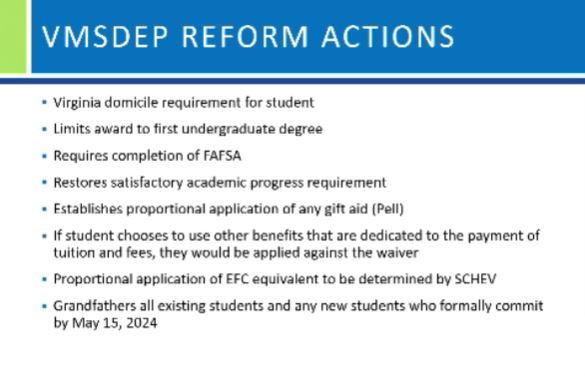
The language in the program grandfathers all existing students and any new students who formally committed to their perspective universities by May 15 of 2024. The budget was signed on May 13.
“So for those individuals the program is unchanged,” said Maggio. “Those that come after May 15, the way it’s written right now would be subject to the provisions of the program. Conversations that we’ve had indicate that might be an issue with the colleges because there is no formal commitment process to attend a Community College.”
Additionally $20 million would be provided annually from the General Fund to help offset the cost of waivers.
“The impact on this, as I said before, is not just an institution impact,” said Maggio. “But it’s an impact primarily on in-state undergraduate students. The idea here was to try to balance this out so that those students weren’t bearing significant cost increases to cover the waivers.”
The first meeting for the task force is scheduled for June 10 in Richmond at the Virginia War Memorial from 2-5 p.m. on June 10.
Owen gave a final statement regarding the situation, part of the statement reads as follows:
“… In my meeting with Mr. Maggio afterward, I was very surprised to learn that DVS, SCHEV and the legislative financial analysts have not met a single time in the last 5 years, or perhaps even longer. It was even more concerning to me that there is no method in place to triangulate data, nor to confirm data between SCHEV, DVS and institutions, all of whom report different numbers for the VMSDEP program. … In addition, there appears to be no data at all on the marginal cost to educate a student, meaning the actual cost, not the cost charged to students. We also refute the notion that the language in the budget bill excludes the mandated use of chapter 35 funds … it is very clear there is a drastic discrepancy between the actual language and intended language, which is why this absolutely must go back to a special session.”
If you’d like to watch the full livestream of the Appropriations Committee Meeting, click here.



